Today we continue our Data Center Executive Roundtable, a quarterly feature showcasing the insights of thought leaders on the state of the data center industry, and where it is headed. In today’s discussion, our panel of experienced data center executives – Aligned Energy CEO Andrew Schaap, Digital Realty CTO Chris Sharp, RagingWire Data Centers Vice President of Marketing James Leach, and Chris Bair, Vice President of Sales and Marketing for Iron Mountain Data Centers – discuss the significance of a wave of new interest from the investment sector.
The conversation is moderated by Rich Miller, the founder and editor of Data Center Frontier.
Data Center Frontier: The data center industry has seen growing interest from new investors and a wave of mergers and acquisitions. How might these trends shape the competitive landscape in 2018?
ANDREW SCHAAP, CEO of Aligned Energy
Andrew Schaap: The strategic publicly-traded operators in our space as well as the investment firms interested in our industry continue to supply great capital at attractive rates, which has resulted in continued growth and support for our end customers.
This creates a nice dynamic environment where not only is outsourcing for data centers growing, but it’s also expanding into what was previously thought of as a “build-it-yourself” mentality in the industry.
The outsourcers are capturing a larger percentage of that pie because of trust in today’s economy and the great capital sources feeding the industry overall.
CHRIS SHARP, Digital Realty
Chris Sharp: I would say there’s a lot of money in the market right now and there’s a lot of uninformed money. There are a lot of people that are trying to come to market and just buy their way into it. If they don’t have the understanding of the complexity of how to procure power, something that people think is very simple, or how to work with a municipality to build out substations, money doesn’t give them that.
There’s been a lot of customer failures that we’ve learned about where people are just trying to go into market, build a data center and forget about it. You’ve got to be very mindful of the expertise and the ability required to operate these facilities on a go-forward basis. Even so, that’s just the bare bones.
The most critical element for success, and this is a massive oversimplification, is the ability to develop and provide the right mix of all of the elements need for success of all of the customer groups that you serve as a data center operator. Achieving just the right balance of fully-interconnected wholesale/scale, retail/colocation and cloud services for enterprises, telcos, cloud providers and content providers, with all of their subsets – it’s hard to even conceive. It’s much harder to do, but that’s the market we’re in, and we feel we’re doing it right.
JAMES LEACH, RagingWire Data Centers
James Leach: According to industry reports, both the volume and size of M&A transactions in the data center industry have been growing at unprecedented levels. There are more deals and bigger deals in the Internet infrastructure sector every year.
Given the volume of these transactions and the decreasing number of available and established data center companies, we believe that there will be more of a “wait and see” attitude in 2018 regarding M&A in the data center industry.
There will continue to be M&A deals in 2018 particularly for companies entering new markets. These deals will be largely driven by buying real estate assets and meeting Wall Street growth projections, as opposed to strategic acquisitions or innovation.
While real estate economic models have been driving investment in data centers over the last few years, data centers have always had a dual personality of real estate and technology. Our view is that data center companies will increasingly become a platform for integrated information and communications technology solutions or ICT. Look for “tuck-in” acquisitions that bring unique ICT services to the data center colocation solution portfolio.
We can watch this trend in the market place. Two of the three largest data center companies in the world, Equinix and Digital Realty, are both Real Estate Investment Trusts (REITs). The remaining data center company of the Top 3, NTT Communications, is an ICT solutions company.
Clearly there is a need for both REITs and ICT companies in the global data center industry. However, we see that in 2018 the added value of ICT will become a key differentiator for enterprise and cloud companies when they select a data center partner.
CHRIS BAIR, Iron Mountain
Chris Bair: We think it will create additional barriers to entry—scale and cost of capital will become increasingly important.
It will be difficult for early stage organizations or companies with higher capital costs to compete against the large, well-funded REIT’s in the sector.
RECAP: Links to all of our Executive Roundtable articles and Executive Insights
Keep pace with the fact-moving world of data centers and cloud computing by following us on Twitter and Facebook, connecting with me on LinkedIn, and signing up for our weekly newspaper using the form below:










